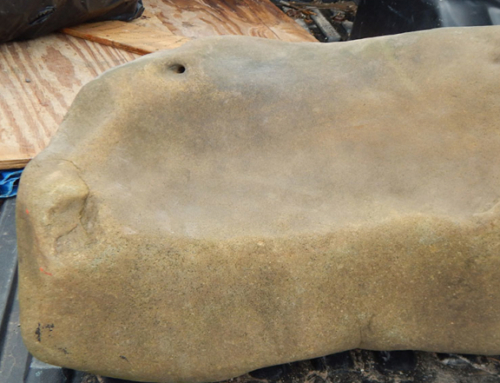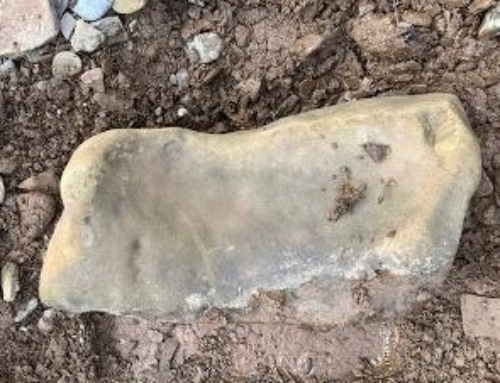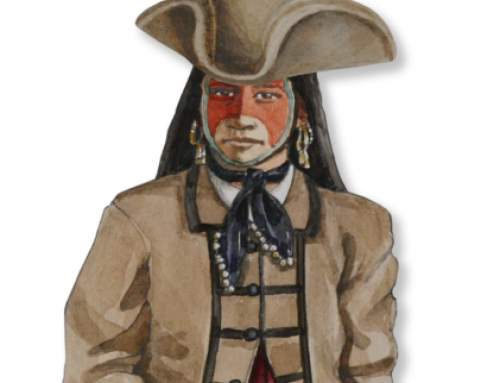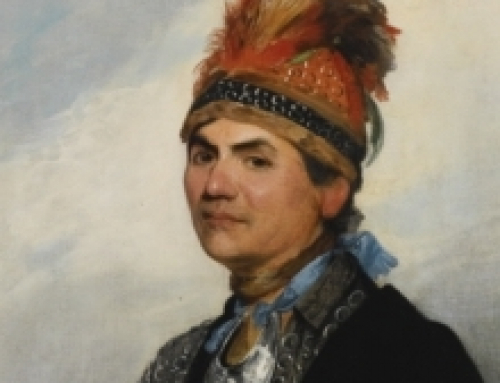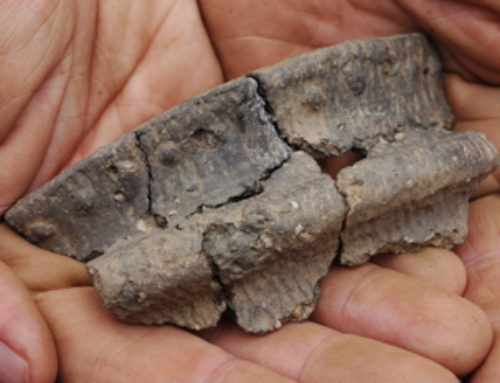Archaeology Find: Drilled Holes in Metate, Bannerstones
Last week we had an artifact found by member Jim Carn and pretty much it’s been a part-time job for me trying to validate the find ever since. Jim actually brought it to my house on the bed of his pickup. At about two feet long and really heavy, Jim was in the right place at the right time to have the artifact transported out of the woods with the help of a few gentlemen on a 4 wheel drive. Now it’s up to the society to authenticate what could be a museum piece. And let me say that where this was found is a well known Indian area. Location can be a big factor in determining validity.
Over the last few days, I have sent pictures to Gary Fogelman, Jim Herbstritt of the State Museum, and all of you. The consensus is that we have a community grinding stone known as a metate. That part of it may be obvious. It is “worked” to form a grinding surface and that surface is different from the rock as a whole. It’s the hole in the artifact that’s a mystery.
Both experts are confounded by the hole. It actually looks good where it’s at but why the hell would it be there? Is it man-made or natural? Did they use it to secure the stone or to display something of their culture? If it’s natural, did native people see it as something special and choose the stone because of it? We’re working on these questions.
Man-made or natural is the first big question. It appears drilled on both ends because of the obvious flare at the top of the drilling. As the chert drill would get larger going up the length of it, the larger part would produce the expanded area outside the hole. In picture 1 you see the hole in the metate. In pictures 2-3 a close up of both sides. It appears drilled from both ends and that would be consistent with typical Indian drilling but over the last few days, my research has produced nothing in that length of drilling and certainly not in an object this large. If you magnify the picture (and you can do that on your computer) it is disturbingly smooth. I know rocks weather but could that happen in the very short geological time man has been here? Tombstones weather. Sometimes you can’t read them after a couple of hundred years. Can that be the answer?
Look at picture 4. This is the hole in a bannerstone ( part of the atlatl spear thrower). If you magnify you’ll see sharp edges around the drilling. It appears the hole was drilled with the typical chert drill but left these edges that you can clearly see. The last picture in all probability was drilled using the hollow reed method. By introducing abrasive grit they would turn the reed and drill a perimeter hole and actually form a core that would be knocked out. I have seen unfinished bannerstones with the core still intact. Notice there is no flaring at the top of the hole.
The drillings in the metate do not meet cleanly but the angle of the other hole forms an elbow. In Jim Herbstritt’s explanation, there might have been organic matter or softer material that might have weathered away forming the hole. Boy, if it did, why the flaring? He suggested a latex cast of the hole. We may actually do that.
Gary and I plan to travel to Jim’s house to examine this anomaly and I’m hoping that we can say soon with a certain degree of certainty that not only is the metate genuine but the drilling also. If that happens we may have one of the longest examples of Native American stone drilling anywhere.
Keep staying safe,
Tank Baird
President NCC8







